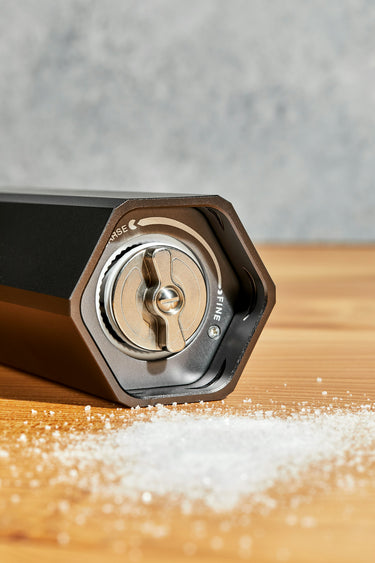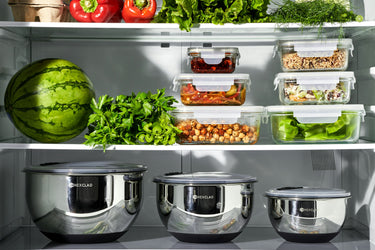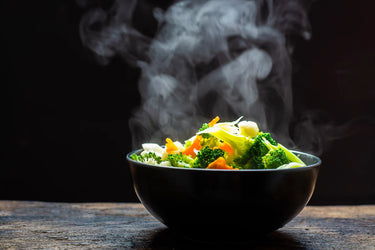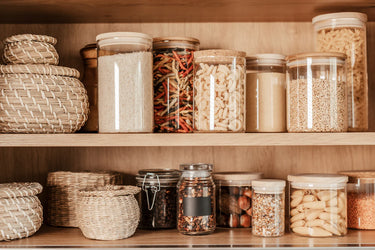A Guide To Salt: The 3 Kinds You Should Have In Your Kitchen

It can make any food taste better, our bodies crave it, and it’s one of the most misunderstood ingredients in the kitchen. We’re talking about salt—a mineral that sometimes seems like culinary magic. But what kind of salt do you need? And do you need more than one kind? Is a salt grinder, ahem, worth its salt? We’ve got the answers to your questions and more in our handy guide to salt.
What is salt?
No matter whether it’s pink, black, white, or gray, all salt is the same mineral, sodium chloride (NaCl). Humans actually need salt—particularly the sodium ions—for the cells in our body to function. (There can be health issues associated with eating too much or too little salt, so if that concerns you, speak with your medical practitioner.)
Though salt doesn’t exactly add flavor, it works as a flavor enhancer. Though exactly how this works isn’t understood, it’s believed that salt might suppress the body’s perception of bitterness. This means that sweet foods taste sweeter and savory foods taste generally more delicious (to a point). Salt also concentrates flavors and makes them more aromatic.
Salt also acts as a preservative. As early as 5,000 to 10,000 years ago, salt was used to cure meats and ferment foods. This was crucial before refrigeration. By reducing the water activity of foods, salt prevents microbial growth and other chemical reactions. Of course, in the present day food supply, the addition of salt is rarely the only method of preventing spoilage. But if you love lacto-fermented pickles, sauerkraut, cheeses, and sausages, then you have salt to thank.
How is salt gathered?
Sea salt is gathered when water evaporates, as in the famous sel de Guérande in France. Ocean salt (as in the kind from Hawaii), is gathered from ocean water. You can also find salts from rivers and lakes, too. The uniform table salt often found in salt shakers can be mined from rock salt mines or gathered through ocean harvesting. It’s processed to remove most minerals other than sodium and chloride (salt’s two chemical building blocks), and then in some instances is sprayed with iodine, which is called iodized salt.
What kinds of salt should you keep in your kitchen?
Though there are untold kinds of specialty salt—from the blush pink Himalayan variety to soft French fleur de sel to jet-black Hawaiian sea salt—specialty salts are exactly that: good for special occasions. Since most people can’t pick up on the tiny flavor variations between salts (and all salt is the same chemicals), going for the fancy kinds is more about enjoying texture and aesthetics.
For everyday cooking jobs, we recommend keeping just a few types on hand.
Kosher salt for cooking
Called “kosher salt” because it was traditionally used to make meat kosher according to Jewish dietary laws. Today, the salt is popular among home cooks for its low density, which allows the salt to be used liberally without using too much. Density varies within kosher salts—Diamond kosher salt is popular for how easy it is to pick up and evenly distribute. The coarse type of kosher salt, sold by Morton, among other brands, is great for your salt grinder.
Fine sea salt for baking
Though kosher salt works just as well in baking, fine sea salt is often called for in baking recipes, so it’s worth keeping on hand. That’s because most American baking recipes call for salt by volume, and the density of crystals is different. E.g. 1 teaspoon of fine sea salt will be much saltier than 1 teaspoon of kosher salt. While that’s easily modified in cooked recipes, you’ll want to get the salt just right in baked goods, which can’t be adjusted later.
Flaky sea salt for garnishing
Again, all salt has an almost identical chemical composition, 100% NaCl. But flaky sea salt adds both texture and a burst of saltiness to finished dishes. Reserve flaky sea salt for places where you’ll really notice it, like sprinkling over cookies before baking, cooked vegetables, perfectly cooked steak, etcetera. Though flaky sea salt (like that from Maldon) is a popular pick for finishing salt, this is a good place to pull out your other specialty salts for finishing.
Coarse salt for your salt grinder
Fill your salt grinder with a coarse, dry salt. As long as the pieces of salt are big enough to grind, you can use any kind. Coarse kosher salt is great if you plan to primarily use the grinder for cooking, or go for a larger sea salt if you plan to use the grinder to finish dishes. No matter what you choose, select a dry salt. Some sea salts—like the Hawaiian kind mentioned above—retain moisture, which would affect the grinder.
Sources:
Eboch, Chris. “Shaking out the Facts about Salt.” American Chemical Society, Feb. 2016, www.acs.org/education/resources/highschool/chemmatters/past-issues/2015-2016/february-2016/salt-facts.html.
Henney, Jane E., et al. Preservation and Physical Property Roles of Sodium in Foods. Www.ncbi.nlm.nih.gov, National Academies Press (US), 2010, www.ncbi.nlm.nih.gov/books/NBK50952/#:~:text=Salt.
---. Taste and Flavor Roles of Sodium in Foods: A Unique Challenge to Reducing Sodium Intake. Www.ncbi.nlm.nih.gov, National Academies Press (US), 2010, www.ncbi.nlm.nih.gov/books/NBK50958/.
PenzeyMoog, Caitlin. “A Guide to Salt, the World’s Most Popular Food.” Serious Eats, 20 Sept. 2019, www.seriouseats.com/guide-to-salt.
Roos, Dave. “How Flavor Enhancers Work.” HowStuffWorks, 30 Mar. 2015, recipes.howstuffworks.com/flavor-enhancers.htm.
SaltWorks. “Choosing the Perfect Gourmet Salt.” Seasalt.com, 2021, seasalt.com/salt-101/gourmet-salt.





